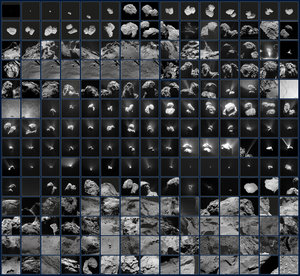Accept all cookies Accept only essential cookies See our Cookie Notice

About ESA
The European Space Agency (ESA) is Europe’s gateway to space. Its mission is to shape the development of Europe’s space capability and ensure that investment in space continues to deliver benefits to the citizens of Europe and the world.
Highlights
ESA - United space in Europe
This is ESA ESA facts Member States & Cooperating States Funding Director General Top management For Member State Delegations European vision European Space Policy ESA & EU Responsibility & Sustainability Annual Report Calendar of meetings Corporate newsEstablishments & sites
ESA Headquarters ESA ESTEC ESA ESOC ESA ESRIN ESA EAC ESA ESAC Europe's Spaceport ESA ESEC ESA ECSAT Brussels Office Washington OfficeWorking with ESA
Business with ESA ESA Commercialisation Gateway Law at ESA Careers Cyber resilience at ESA IT at ESA Newsroom Partnerships Merchandising Licence Education Open Space Innovation Platform Integrity and Reporting Administrative Tribunal Health and SafetyMore about ESA
History ESA Historical Archives Exhibitions Publications Art & Culture ESA Merchandise Kids Diversity ESA Brand Centre ESA ChampionsLatest
Space in Member States
Find out more about space activities in our 23 Member States, and understand how ESA works together with their national agencies, institutions and organisations.
Science & Exploration
Exploring our Solar System and unlocking the secrets of the Universe
Go to topicAstronauts
Missions
Juice Euclid Webb Solar Orbiter BepiColombo Gaia ExoMars Cheops Exoplanet missions More missionsActivities
International Space Station Orion service module Gateway Concordia Caves & Pangaea BenefitsLatest
Space Safety
Protecting life and infrastructure on Earth and in orbit
Go to topicAsteroids
Asteroids and Planetary Defence Asteroid danger explained Flyeye telescope: asteroid detection Hera mission: asteroid deflection Near-Earth Object Coordination CentreSpace junk
About space debris Space debris by the numbers Space Environment Report In space refuelling, refurbishing and removingSafety from space
Clean Space ecodesign Zero Debris Technologies Space for Earth Supporting Sustainable DevelopmentLatest
Applications
Using space to benefit citizens and meet future challenges on Earth
Go to topicObserving the Earth
Observing the Earth Future EO Copernicus Meteorology Space for our climate Satellite missionsCommercialisation
ESA Commercialisation Gateway Open Space Innovation Platform Business Incubation ESA Space SolutionsLatest
Enabling & Support
Making space accessible and developing the technologies for the future
Go to topicBuilding missions
Space Engineering and Technology Test centre Laboratories Concurrent Design Facility Preparing for the future Shaping the Future Discovery and Preparation Advanced Concepts TeamSpace transportation
Space Transportation Ariane Vega Space Rider Future space transportation Boost! Europe's Spaceport Launches from Europe's Spaceport from 2012Latest

Comet cat
Thank you for liking
You have already liked this page, you can only like it once!
From a distance of five million kilometres to within 20 metres, ESA’s Rosetta spacecraft captured images of Comet 67P/Churyumov-Gerasimenko from all angles.
Between the first and the last images lies one of humankind’s greatest space adventures to rendezvous with and follow a comet as it orbited the Sun, and deploy a lander to its surface.
Seen from afar, the comet is usually likened to a duck in shape, but in this enchanting close-up view its profile resembles that of a cat’s face seen side-on.
The two ‘ears’ of the cat make up the twin peaks either side of the ‘C. Alexander Gate’ – named for US Rosetta Project Scientist Claudia Alexander who passed away in July 2015. These impressive cliffs lie at the border between the Serqet and Anuket regions on the comet’s head. The image was taken on 6 October 2014 from a distance of 18.6 km to the comet.
This is just one of almost 70 000 images taken with Rosetta’s high-resolution imaging system OSIRIS that are now available via a new online and mobile-friendly ‘comet viewer’ created in a joint project with the Department of Information and Communication at Flensburg University of Applied Sciences, and the Max Planck Institute for Solar System Research, who lead the OSIRIS team.
The image viewer hosts the full archive, but also has subsections organising image sets into themes: for example, images showing towering cliffs and bizarre cracks on the comet surface, or those focusing on spectacular dust fountains as the comet launched gas and dust jets into space as its surface ices were warmed as it came closer to the Sun on its orbit.
The collection of OSIRIS images captured the farewell of lander Philae as it dropped towards the surface of the comet, and later, towards the end of the mission, the feverish search for the hidden robot.
Within the new comet viewer, each of the nearly 70 000 images is supplemented with the date on which it was taken, the distance to the comet, and a short accompanying text briefly describing what is seen in the image. The images can be downloaded in full resolution and can also be directly shared to Twitter and Facebook.
For users who wish to delve deeper or use the archive for research purposes, the images are also available in scientific data format; in addition, there is information available on the filters used, focal lengths, and exposure times as well as references to the scientific documentation and evaluation software.
The tool supplements the official ESA Archive Image Browser which also hosts the images taken by Rosetta’s navigation camera made available throughout the mission, and ESA's Planetary Science Archive, for which the OSIRIS image archive was completed in June 2018.
Read more: https://www.mps.mpg.de/One-comet-70000-images
Explore the image viewer at https://rosetta-osiris.eu
Click here to access the original image pictured here and associated data from within the new tool.
-
CREDIT
ESA/Rosetta/MPS for OSIRIS Team MPS/UPD/LAM/IAA/SSO/INTA/UPM/DASP/IDA (CC BY-SA 4.0) -
LICENCE
ESA Standard Licence

Rosetta’s ever-changing view of a comet

Comet storm

Comet rotation and regions

Comet surface changes, annotated















 Germany
Germany
 Austria
Austria
 Belgium
Belgium
 Denmark
Denmark
 Spain
Spain
 Estonia
Estonia
 Finland
Finland
 France
France
 Greece
Greece
 Hungary
Hungary
 Ireland
Ireland
 Italy
Italy
 Luxembourg
Luxembourg
 Norway
Norway
 The Netherlands
The Netherlands
 Poland
Poland
 Portugal
Portugal
 Czechia
Czechia
 Romania
Romania
 United Kingdom
United Kingdom
 Slovenia
Slovenia
 Sweden
Sweden
 Switzerland
Switzerland
























